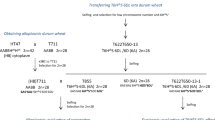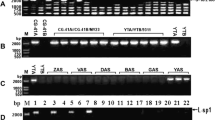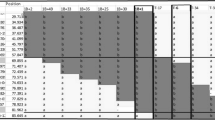Abstract
A new CMS system designated as ‘msH1’ has been reported in bread wheat using the cytoplasm of H. chilense. While testing this system in different wheat backgrounds, a highly fertile line with chromosome number 42 plus an extra acrocentric chromosome was obtained. The extra chromosome did not pair with any wheat chromosome at meiosis, and progeny from this line which lack the acrocentric chromosome showed pollen abortion and male sterility. In order to establish the origin of this chromosome, FISH using H. chilense genomic DNA as probe was used and showed that it had originated from H. chilense chromosome(s). The novel chromosome did not possess sequences similar to wheat rDNA; however, the probe pSc119.2 from S. cereale containing the 120 bp family was found to occur at the end of its long arm. Data obtained from FISH and EST molecular markers confirm that the long arm of the acrocentric chromosome is indeed, the short arm of chromosome 1Hch from H. chilense. We suggest that the novel chromosome originated from a deletion of the distal part of the long arm of chromosome 1Hch. Neither the 1HchS short arm, nor the whole chromosome 1Hch restores pollen fertility of the alloplasmic wheat. Therefore, the restorer gene on the acrocentric chromosome must be located on the retained segment from the hypothetical 1HchL, while some pollen fertility inhibitor could be present on the deleted 1HchL distal segment. Disomic addition of the acrocentric chromosome was obtained and this line resulted fully stable and fertile.





Similar content being viewed by others
References
Aksyonova E, Sinyavskaya M, Danilenko N, Pershina L, Nakamura C, Davydenko O (2005) Heteroplasmy and paternally oriented shift of the organellar DNA composition in barley–wheat hybrids during backcrosses with wheat parents. Genome 48:761–769
Atienza SG, Ramírez MC, Hernández P, Martín A (2004) Chromosomal location of genes for carotenoid pigments in Hordeum chilense. Plant Breed 123:303–304
Atienza SG, Ballesteros J, Martín A, Hornero-Mández D (2007) Genetic variability of carotenoid concentration and degree of esterification among Tritordeum (Tritordeum Ascherson et Graebner) and durum wheat accessions. J Agric Food Chem 55:4244–4251
Badaeva ED, Pershina LA, Bil’danova LL (2006) Cytogenetic analysis of alloplasmic recombinant lines (H. vulgare)-T. aestivum unstable in fertility and viability. Rus J Genet 42:140–149
Bothmer Rv, Giles BE, Jacobsen N (1986) Crosses and genome relationship in the Hordeum patagonicum group. Genetica 71:75–80
Cabrera A, Martín A, Barro F (2002) In situ comparative mapping (ISCM) of Glu-1 loci in Triticum and Hordeum. Chromosome Res 10:49–54
Chung SM, Staub JE (2003) The development and evaluation of consensus chloroplast primer pairs that possess highly variable sequence regions in a diverse array of plant taxa. Theor Appl Genet 107:757–767
de Bustos A, Cuadrado A, Soler C, Jouve N (1996) Physical mapping of repetitive DNA sequences and 5 s and 18 s–26 s rDNA in five wild species of the genus Hordeum. Chromosome Res 4:491–499
Doyle JJ, Doyle JH (1990) Isolation of plant DNA from fresh tissue. Focus 12:13–15
Gerlach WL, Bedbrook JR (1979) Cloning and characterization of ribosomal RNA genes from wheat and barley. Nucleic Acids Res 7:1869–1885
Islam AKMR, Shepherd KW (1990) Incorporation of barley chromosomes into wheat. In: Bajaj YPS (ed) Biotechnology in agriculture and forestry, vol 13. Springer, Berlin, pp 128–151
Islam AKMR, Shepherd KW (2000) Isolation of a fertile wheat–barley addition line carrying the entire barley chromosome 1H. Euphytica 111:145–149
Islam AKMR, Shepherd KW, Sparrow DHB (1981) Isolation and characterization of euplasmic wheat–barley chromosome addition lines. Heredity 46:161–174
Künzel G, Korzum L, Meister A (2000) Cytologically integrated physical restriction fragment length polymorphism maps for the barley genome based on translocation breakpoints. Genetics 154:397–412
Marín S, Martín A, Barro F (2008) Comparative FISH mapping of two highly repetitive DNA sequences in Hordeum chilense (Roem et Schult.). Genome 51:580–588
Martín A, Chapman V (1977) A hybrid between Hordeum chilense and Triticum aestivum. Cereal Res Commun 4:365–368
Martín A, Martínez C, Rubiales D, Ballesteros J (1996) Tritordeum: triticale′s new brother cereal. In: Güedes-Pinto H, Darvey N, Carnide VP (eds) Triticale: today and tomorrow. Kluwer, Dordrecht, pp 57–72
Martín A, Martín LM, Cabrera A, Ramírez MC, Giménez MJ, Rubiales D, Hernández P, Ballesteros J (1998) The potential of Hordeum chilense in breeding Triticeae species. In: Jaradat AA (ed) Triticeae III. Science Publishers, Enfield, pp 377–386
Martín A, Álvarez JB, Martín LM, Barro F, Ballesteros J (1999) The development of tritordeum: a novel cereal for food processing. J Cereal Sci 30:85–95
Martín AC, Atienza S, Ramírez MC, Barro F, Martín A (2008a) Male fertility restoration of wheat in Hordeum chilense cytoplasm is associated with 6HchS chromosome addition. Aust J Agric Res 59:206–213
Martín AC, Atienza SG, Barro F (2008b) Use of ccSSR markers for the determination of the purity of alloplasmic wheat in different Hordeum cytoplasms. Plant Breed 127:470–475
Martín AC, Ramírez MC, Atienza SG, Barro F, Martín A (2009) Chromosome engineering in wheat to restore male fertility in the msH1 CMS system. Mol Breed 24:397–408
McIntryre C, Pereira S, Moran L, Appels R (1990) New Secale cereale (rye) DNA derivatives for the detection of rye chromosome segments in wheat. Genome 33:635–640
Murata M, Nakata N, Yasumuro Y (1992) Origin and molecular structure of a midget chromosome in a common wheat carrying rye cytoplasm. Chromosoma 102:27–31
Nasuda S, Kikkawa Y, Ashida T, Rafiqul AKM, Sato K, Endo TR (2005) Chromosomal assignment and deletion mapping of barley EST markers. Genes Genet Syst 80:357–366
Pickett AA (1993) Hybrid wheat: results and problems. Adv Plant Breed Supplement 15:1–259
Pistón F, Martín A, Dorado G, Barro F (2005) Cloning and molecular characterization of B-hordeins from Hordeum chilense (Roem. et Schult.). Theor Appl Genet 111:551–560
Prieto P, Ramírez MC, Ballesteros J, Cabrera A (2001) Identification of intergenomic translocations involving wheat, Hordeum vulgare and Hordeum chilense chromosomes by FISH. Hereditas 135:171–174
Raupp WJ, Friebe B, Gill BS (1995) Suggested guidelines for the nomenclature and abbreviation of the genetic stock of wheat and its relatives. Wheat Inf Serv 81:51–55
Taketa S, Takeda K (1997) Expression of dominant marker genes of barley in wheat–barley hybrids. Genes Genet Syst 72:101–106
Taketa S, Ando H, Takeda K, Bothmer Rv (2001) Physical locations of 5S and 18S–25S rDNA in Asian and American diploid Hordeum species with the I genome. Heredity 86:522–530
Taketa S, Choda M, Ohashi R, Ichii R, Takeda K (2002) Molecular and physical mapping of a barley gene on chromosome arm 1HL that causes sterility in hybrids with wheat. Genome 45:617–625
Tsujimoto H, Panayotov I, Tsunewaki K (1987) Behaviour of an extra chromosome carried by alloplasmic common wheat lines having Agropyron trichophorum cytoplasm. Jpn J Genet 62:291–299
Tsunewaki K (1980) Basic studies on hybrid wheat breeding utilizing the timopheevi cytoplasm and Rf3 gene—summary of the results. Seiken Ziho 29:40–56
Wilson JA, Ross VM (1962) Male sterility interaction of Triticum aestivum nucleous and Triticum timopheevii cytoplasm. Wheat Inf Serv 14:29–30
Acknowledgments
This work was supported by MICINN (Ministerio de Ciencia e Innovación) project AGL2007-65685-C02-01 and AGL2009-11359 of the Spanish Government.
Author information
Authors and Affiliations
Corresponding author
Additional information
Communicated by B. Friebe.
Rights and permissions
About this article
Cite this article
Martín, A.C., Atienza, S.G., Ramírez, M.C. et al. Molecular and cytological characterization of an extra acrocentric chromosome that restores male fertility of wheat in the msH1 CMS system. Theor Appl Genet 121, 1093–1101 (2010). https://doi.org/10.1007/s00122-010-1374-x
Received:
Accepted:
Published:
Issue Date:
DOI: https://doi.org/10.1007/s00122-010-1374-x




